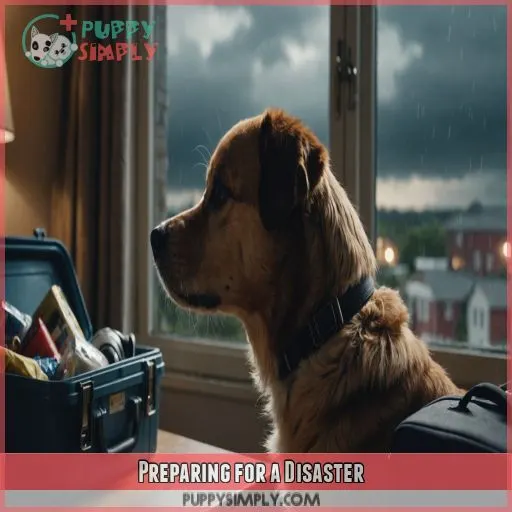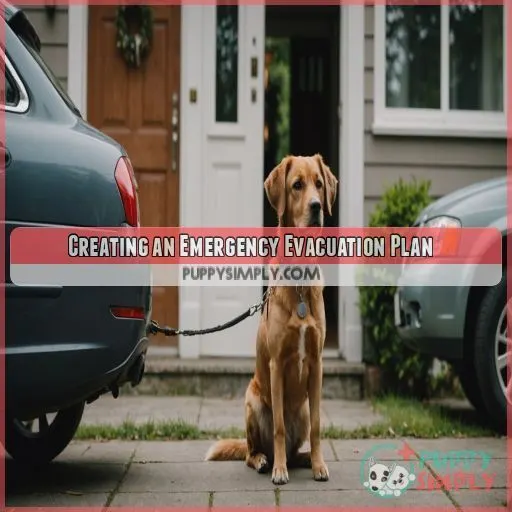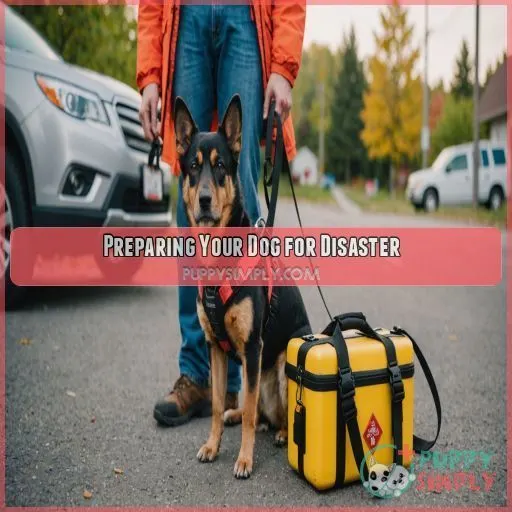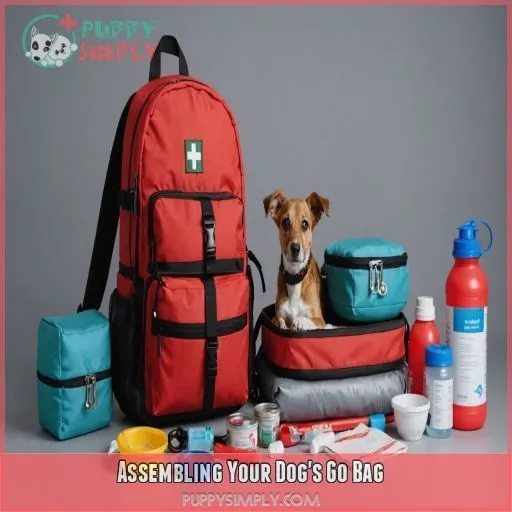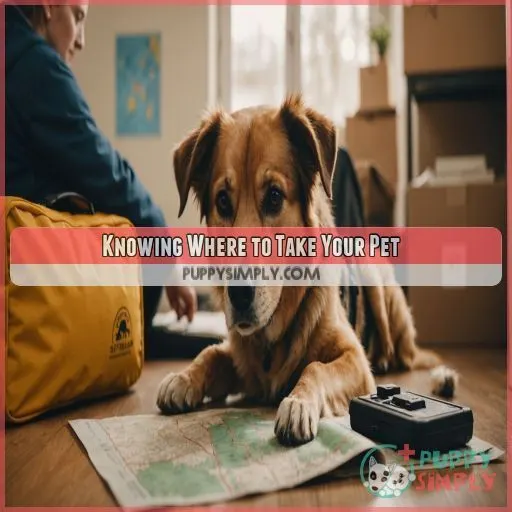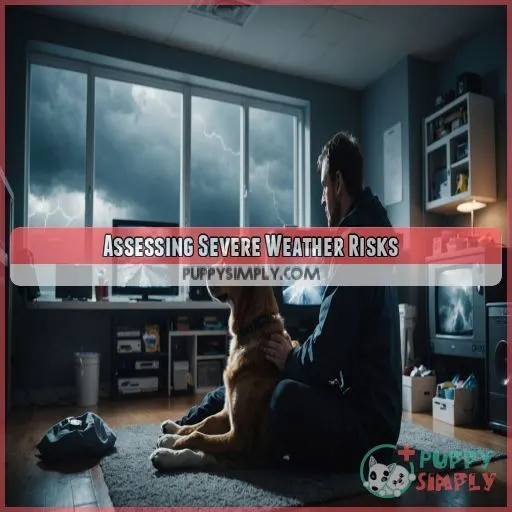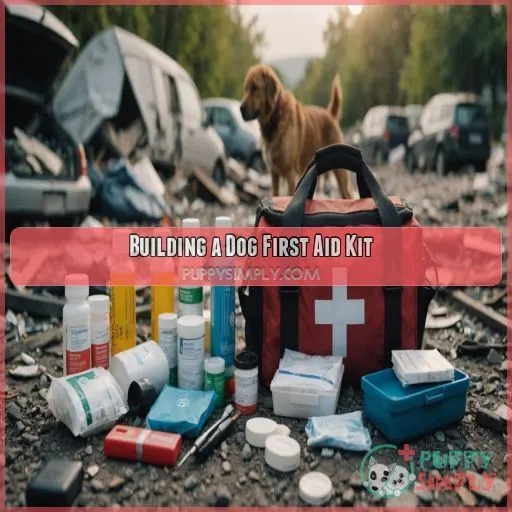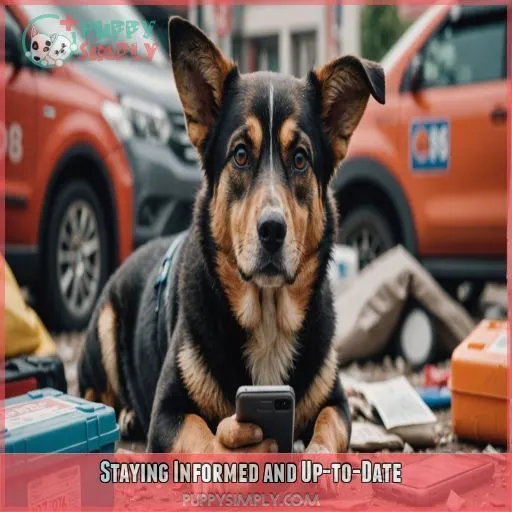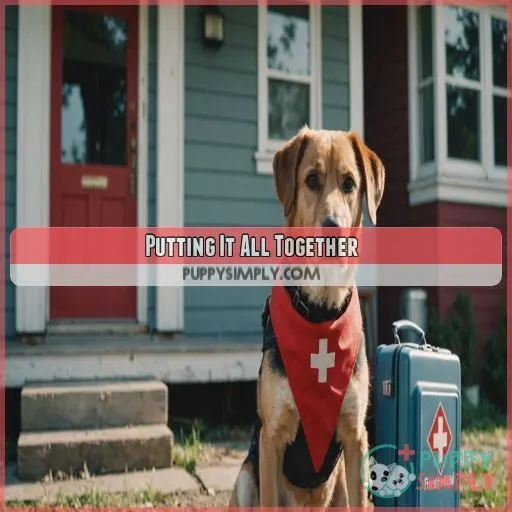This site is supported by our readers. We may earn a commission, at no cost to you, if you purchase through links.
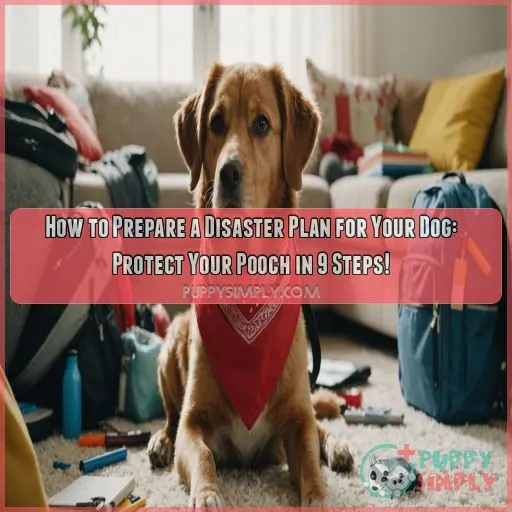
Start by figuring out how you’ll get out of dodge with your pup, and pack a doggy go-bag with the essentials like food, water, and meds.
Don’t forget to update your dog’s ID tags and microchip info—you don’t want Fido getting lost in the chaos!
Look up pet-friendly shelters and hotels in your area, and choose a trusted friend to be your backup caregiver.
Practice evacuation drills with your pooch to make sure you can get out of there smoothly if disaster strikes.
Ready to become a pet disaster prep pro?
Table Of Contents
- Key Takeaways
- Preparing for a Disaster
- Creating an Emergency Evacuation Plan
- Preparing Your Dog for Disaster
- Assembling Your Dog’s Go Bag
- Knowing Where to Take Your Pet
- Assessing Severe Weather Risks
- Building a Dog First Aid Kit
- Staying Informed and Up-to-Date
- Putting It All Together
- Frequently Asked Questions (FAQs)
- How do I protect my pet from a disaster?
- What should a pet disaster preparedness kit include?
- How do I prepare my pet for an emergency?
- Why is pet disaster preparedness important?
- How to prepare your dog for an emergency?
- What should be in an emergency kit for pets?
- What are the steps in preparing a disaster plan?
- What are the four phases of emergency management in animals in disaster?
- How do I calm my dog during a disaster?
- What if my dog refuses to evacuate with me?
- Can I leave my dog at home during evacuation?
- How long will evacuation shelters typically house pets?
- What if my dog gets separated during evacuation?
- Conclusion
Key Takeaways
- You’ve got a critical role in keeping your furry friend safe during disasters, and it starts with creating a solid emergency plan that includes your dog – think of it as a "fetch and run" drill for the whole pack!
- Having a well-stocked "go bag" for your dog is essential – pack essentials like food, water, medications, and comfort items like favorite toys or blankets to reduce stress during a crisis. Don’t forget to update those ID tags and microchip info!
- You’ll want to know exactly where your furry friend can stay safe during an emergency, so research pet-friendly shelters and hotels in advance. Consider asking a trusted friend or family member to be your backup caregiver – it’s like having a backup parachute for your pup!
- Practicing evacuation drills with your dog will help you both stay calm and prepared in case of an emergency. Think of it as your secret handshake for safety. Remember to stay informed and up-to-date on your emergency plan and kit to keep your furry friend safe and sound!
Preparing for a Disaster
You never know when disaster might strike, so it’s really important to have a plan in place for your furry friend. Let’s explore how to prepare for emergencies and keep your dog safe, starting with understanding key laws and creating a solid evacuation strategy.
Understanding the Pets Act and State Laws
You’ve got legal backup for your furry friend! The Pets Act requires states to include pets in evacuation plans. Over 30 states have similar laws. It’s not just about your pup’s safety; it’s your right to protect them during disasters.
Creating a Household Emergency Evacuation Plan
Now that you’re up to speed on the Pets Act, let’s create your family’s escape plan. Your furry friend is part of the family, so include them in your emergency evacuation strategy. Think of it as a "fetch and run" drill for the whole pack!
Assigning a Pet Care Arrangement
Don’t leave your furry friend in the lurch! Set up a pet care arrangement with a trusted neighbor or pet sitter. Make sure they’ve a spare key, your vet’s contact info, and know where to find your pup’s disaster preparedness kit. It’s peace of mind on four legs!
Placing a Rescue Alert Sticker on Your Front Door
Place a rescue alert sticker on your front door – it’s your pup’s lifeline in an emergency! Include your dog’s name, your vet’s number, and any special needs. It’s a small step that could make a big difference when every second counts.
Creating an Emergency Evacuation Plan
When disaster strikes, your furry friend is counting on you to have a solid plan. Creating an emergency evacuation plan for your dog isn’t just smart—it’s essential for keeping your four-legged family member safe and sound when things go sideways.
Developing a Quick Departure Plan With Your Dog
Ready to hit the road in a flash? Create a quick departure plan for you and your furry friend. Pack a pet carrier, emergency kit, and safe transportation essentials. Don’t forget to practice drills – they’re not just for school! Set up emergency alerts and have a backup plan. Your dog’s disaster preparedness starts with you!
Planning for Separation From Your Dog
Planning for separation from your furry friend can be ruff, but it’s really important for their safety. Here are three key steps to make sure your pup’s well-being is taken care of:
- Create a list of emergency contacts
- Arrange a reliable dog sitter
- Prepare a detailed care guide
Identifying Pet-Friendly Shelters and Hotels
Now that you’ve planned for separation, let’s talk about finding a safe haven for your furry friend. Don’t leave it to chance! Research pet-friendly shelters and hotels in advance. Check online resources, call local contacts, and compare costs. Remember, some places have weight limits or breed restrictions, so have backup options ready. Your pup’s comfort matters!
Preparing Your Dog for Disaster
When disaster strikes, your furry friend is counting on you to be prepared. Let’s walk through the essential steps to make sure your pup’s safety and well-being during an emergency, from keeping their shots up-to-date to packing a doggy go-bag.
Keeping Vaccinations Up to Date
Now that you’ve got your evacuation plan, let’s keep your pup healthy. Staying on top of vaccinations is really important. Here’s what you need to do:
- Schedule regular check-ups
- Keep a vaccination record handy
- Ask about disaster-specific shots
Your furry friend will thank you!
Microchipping Your Dog and Updating Registration
After keeping Fido’s shots up-to-date, it’s time to get him chipped! Microchipping is your furry friend’s high-tech ID. It’s a quick procedure that’ll give you peace of mind during disasters. Remember to keep that registration current – it’s your ticket to a happy reunion!
Ensuring Identification Tags and Collars
Besides microchipping, make sure your pup wears a sturdy collar with up-to-date ID tags. It’s like giving your furry friend a lifejacket in a storm of chaos. Choose durable, easy-to-read tags that’ll help reunite you if disaster strikes.
Gathering Important Documents and Contact Information
Don’t forget your pup’s paperwork! Gather vet records, emergency contacts, and pet insurance details. Toss in microchip info and vaccination history too. It’s like packing your dog’s life story in a folder – you’ll thank yourself later if disaster strikes!
Assembling Your Dog’s Go Bag
When disaster strikes, you’ll want to be ready to grab your pup and go at a moment’s notice. Putting together a well-stocked "go bag" for your dog means you’ll have everything they need to stay safe, comfortable, and healthy during an emergency.
Packing Essentials Like Food, Water, and Bowls
When packing your pup’s go-bag, don’t forget the essentials! Think of it as prepping for a doggy picnic, but with a dash of "just in case." Here’s what you’ll need:
- Dry food in airtight containers
- Bottled water (for both of you!)
- Collapsible bowls for easy storage
- Travel-friendly feeders
- Waterproof food storage bags
Including Medications, Tick Prevention, and Heartworm Treatment
Don’t forget your furry friend’s meds! Pack a month’s supply of any prescriptions, along with tick prevention and heartworm treatment. Store them in a waterproof container and include dosage instructions. It’s like packing a doggy pharmacy for your adventure together!
Adding Comfort Items Like Toys and Bedding
Don’t forget your pup’s favorite comforts! Toss in their beloved squeaky toy, that ratty old blanket they can’t live without, and their go-to bed. These familiar scents and textures will help keep your furry friend calm during stressful times.
Including Stress Relief Items Like Anxiety Vests
Don’t forget to pack your pup’s anxiety vest or calming aids. These can be lifesavers when your furry friend’s world is turned upside down. Remember, a calm dog is easier to handle in a crisis. Consider including familiar scents or a favorite toy too.
Knowing Where to Take Your Pet
When disaster strikes, knowing where to take your furry friend is really important for their safety and your peace of mind. Let’s explore your options for sheltering your pup during an emergency, from pet-friendly hotels to trusted family members who can lend a helping paw.
Researching Local Shelters and Pet-Friendly Options
When disaster strikes, you’ll want to know exactly where your furry friend can stay safe. Don’t wait until the last minute to research pet-friendly options. Here are three key steps to take:
- Call local shelters to check their pet policies and capacity
- Scout out pet-friendly hotels within a 100-mile radius
- Look up nearby boarding kennels that accept dogs during emergencies
Contacting Family and Friends Outside the Evacuation Area
Don’t forget to reach out to your family and friends outside the danger zone.
They might be your dog’s ticket to safety!
Create an emergency contact list with their numbers and addresses.
Discuss pet care arrangements and travel logistics in advance.
It’s like having a backup parachute for your furry friend.
Having out-of-state options gives you peace of mind when local shelters are packed.
Plus, your pup might enjoy a little vacation from the chaos!
Assessing Severe Weather Risks
You can’t control the weather, but you can control how prepared you’re for it. Understanding the natural disaster risks in your area and creating a plan for severe weather emergencies are important steps in keeping your furry friend safe when Mother Nature throws a curveball.
Understanding Natural Disaster Risks in Your Area
Now that you know where to take your furry friend, let’s talk about the weather – and not just for small talk! Understanding the natural disaster risks in your area is really important for keeping your pup safe. Think of it as being a meteorologist for your mutt. Here’s what you need to know:
- Check your local flood zones
- Assess wildfire risk in your region
- Research earthquake preparedness for your area
- Familiarize yourself with tornado warning systems
Creating a Plan for Severe Weather Emergencies
When severe weather hits, you need to be ready.
Think of it like playing chess with Mother Nature – you want to anticipate her next move.
Start by figuring out what kind of weather threats are common in your area, like hurricanes, tornadoes, or floods.
Then, map out different ways to get out of danger and safe places to go.
Don’t forget to gather emergency supplies and plan how you’ll stay in touch with family.
And remember, your furry friend is counting on you, so include pet safety in your plan.
Stay weather-wise, and you’ll both weather any storm!
Building a Dog First Aid Kit
You wouldn’t leave home without a first aid kit for yourself, so why not have one for your furry friend too? Building a dog first aid kit is an essential part of your disaster preparedness plan, ensuring you’re ready to handle any minor injuries or health issues your pup might face during an emergency.
Including Essential Supplies Like Bandages and Antiseptic Wipes
- Bandages (various sizes)
- Antiseptic wipes
- Sterile gauze pads
- Tweezers
These items are your furry friend’s frontline defense against minor mishaps. Remember, being prepared is like giving your pooch a metaphorical suit of armor!
Adding Medications and Treatments for Common Injuries
Now, let’s beef up your dog’s first aid kit with meds for common injuries. Pack some canine-friendly pain relief, antihistamines for allergic reactions, and vet-approved anti-diarrhea meds. Don’t forget wound care essentials like saline solution and antibiotic ointment. These additions will have you ready to tackle unexpected boo-boos like a pro!
Creating a Pet First Aid Guide
Creating a pet first aid guide is like having a trusty sidekick for your furry friend in times of need. It’s a game-changer when emergencies strike. Here’s what to include:
- Common dog injuries and their symptoms
- Step-by-step instructions for basic treatments
- Pet CPR and rescue breathing techniques
- Emergency vet contacts and nearby animal hospitals
Staying Informed and Up-to-Date
Being prepared for a disaster isn’t a one-and-done deal, it’s an ongoing process that requires your attention. Staying informed and up-to-date is really important to keeping your furry friend safe when the unexpected strikes, so let’s talk about how to stay on top of your game.
Staying Current on Dog Vaccines and Microchip Information
Keeping your pup’s vaccines and microchip info up-to-date isn’t just good pet parenting, it’s really important for disaster readiness. Think of it as your furry friend’s personal "ID card" in case of emergency. Here’s a quick guide to help you stay on top of things:
| Vaccine | Frequency | Why It Matters |
|---|---|---|
| Rabies | 1-3 years | Legal requirement |
| DHPP | 1-3 years | Protects against common diseases |
| Microchip | Once, update info annually | Helps reunite lost pets |
Monitoring Weather Reports and Emergency Alerts
Stay weather-wise by keeping your finger on the pulse of Mother Nature. Download reliable weather apps and enable emergency alerts on your phone. It’s like having a meteorologist in your pocket! Keep an eye on local forecasts and track any brewing storms. Remember, for your pup’s safety, knowledge is power.
Updating Your Emergency Plan and Kit Regularly
Don’t let your emergency plan gather dust! Keep your pooch safe by regularly updating your kit and strategy. Here’s a quick checklist to refresh your prep:
- Check food and medication expiration dates
- Replace old photos with recent ones
- Update contact information for vets and shelters
- Review your evacuation route and meeting spots
Stay on top of it!
Putting It All Together
Now that you’ve got all the pieces in place, it’s time to put your dog’s disaster plan into action. Let’s tie everything together to make sure you and your furry friend are ready for whatever Mother Nature throws your way.
Creating a Comprehensive Emergency Plan
Now that you’ve got all the pieces, it’s time to put them together. Your plan should be a well-oiled machine, ready to spring into action at a moment’s notice. Gather your emergency supplies, map out evacuation routes, and establish clear family communication protocols. Don’t forget to include shelter options for your furry friend!
Practicing Your Emergency Plan With Your Dog
Now that you’ve got your plan on paper, it’s time to put it into action! Practice drills with your furry friend to iron out any kinks. Run a mock evacuation, keeping an eye on your dog’s behavior. Stay calm – your pooch will pick up on your vibe. Identify safety zones and make sure everyone in the family knows the drill.
Reviewing and Updating Your Plan Regularly
Now that you’ve practiced, it’s time to keep your plan fresh. Life changes, and so should your disaster prep. Here’s how to stay on top of it:
- Review your Emergency Kit quarterly
- Update Contact Info annually
- Check Weather Alerts systems monthly
- Note Plan Changes as they happen
Frequently Asked Questions (FAQs)
How do I protect my pet from a disaster?
You’ve got this! Create a go-bag with essentials, keep ID tags updated, and know pet-friendly evacuation spots. Don’t forget comfort items – your furry friend needs emotional support too. Stay prepared, stay together!
What should a pet disaster preparedness kit include?
Did you know 68% of pet owners don’t have a disaster plan? Don’t be caught off guard! Your pet’s kit should include food, water, meds, first-aid supplies, comfort items, and important docs. Be ready to grab and go!
How do I prepare my pet for an emergency?
Keep your furry friend ready for anything! Update vaccinations, microchip, and ID tags. Pack a go-bag with essentials like food, water, and meds. Practice evacuation drills together – it’ll be your secret handshake for safety!
Why is pet disaster preparedness important?
Ever wondered if your furry friend’s ready for the unexpected? Pet disaster preparedness isn’t just a precautionit’s a lifeline. You’ll protect your dog’s safety, guarantee their comfort, and gain peace of mind during chaotic times. Don’t waitplan now!
How to prepare your dog for an emergency?
Get your dog emergency-ready! Keep vaccinations up-to-date, microchip them, and see that they wear identification tags. Pack essentials like food, water, and medications in a go-bag, and have a plan for separation, just in case.
What should be in an emergency kit for pets?
Let’s get your pet’s emergency kit ‘paws-itively’ ready! Include essentials like water, non-perishable food, a first-aid kit, medications, and comfort items like favorite toys or blankets to reduce stress during a crisis.
What are the steps in preparing a disaster plan?
To prepare a disaster plan, start by developing a household evacuation plan that includes your pet. Identify safe zones, escape routes, and a meeting point. Then, assemble a pet emergency kit and know where to take your pet.
What are the four phases of emergency management in animals in disaster?
Imagine your furry friend’s terrified eyes – a heart-wrenching thought! To avoid that, know the four phases of emergency management: mitigation (pre-disaster prep), preparedness (having a plan), response (evacuating), and recovery (returning home safely).
How do I calm my dog during a disaster?
During a disaster, calm your dog with familiar comfort items like toys, blankets, and treats. Consider stress-relieving tools like anxiety vests, calming sprays, or pheromone diffusers to help keep them chill amidst chaos.
What if my dog refuses to evacuate with me?
Did you know 62% of pet owners consider their pets family? So, what if your furry ‘family member’ refuses to evacuate? Stay calm, use treats and toys to coax them, and consider a carrier or harness for safe transport.
Can I leave my dog at home during evacuation?
How long will evacuation shelters typically house pets?
Imagine a shelter as a temporary haven, not a long-term home. Typically, evacuation shelters will house pets for a few days to a week, so you’ll need to plan for their care beyond that timeframe.
What if my dog gets separated during evacuation?
Don’t panic! If your dog gets separated during evacuation, contact local shelters, animal control, and your vet. Microchipping and up-to-date identification tags can help guarantee a happy reunion. Stay calm and persistent – you got this!
Conclusion
Did you know 67% of households in the US own a pet, yet many aren’t prepared for disasters?
Don’t let your furry friend fall through the cracks! By following these 9 steps, you’ll be well on your way to becoming a pet disaster prep pro.

